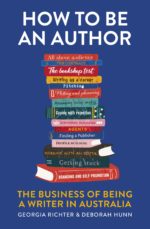Top tips from Fremantle Press for anyone taking on NaNoWriMo this year

We’re just one month away from the start of National Novel Writing Month (#NaNoWriMo) where thousands of emerging writers across the world take part in a challenge to write a 50,000 word novel between 1 and 30 November.
Debut novelist Carrie Cox shares how her book Afternoons with Harvey Beam would never have been written if it weren’t for NaNoWriMo. City of Fremantle T.A.G. Hungerford Award winner and Vodka and Apple Juice author Jay Martin gives her tips on where to find inspiration. And James Foley, author and illustrator of the S.Tinker Inc. series, explains how you don’t have to be just a writer to set yourself a creative challenge. These plus top tips from our publisher Georgia Richter and editor Armelle Davies will provide all you need for a productive NaNoWriMo.
Carrie Cox, journalist and author of Afternoons with Harvey Beam
I actually wouldn’t have a book without NaNoWriMo. My daughter, a keen writer and prolific reader, told me about it several years ago and asked if I would do it with her as a sort of motivational support person. We thought we were more likely to stick with it as a pair.
Of course, being 19 years old at the time, my daughter got sick of it by around day two, but I stuck with it. I was already on board with the concept and I had a half an idea for a story I was willing to put to the test. By the end of 30 days, I had 35,000 words I was relatively happy with – not a novel by any stretch but I’d broken the back of it. I’d run two thirds of a marathon and wasn’t about to quit now.
Here are my tips:
• Make use of all the support tips, blogs, chat rooms and online encouragement attached to NaNoWriMo. I availed myself of none of it, but I probably should have because it looked pretty good.
• Think of it like a diet. If you think about not eating carbs for 30 days, it won’t be long before you quit. You’ll be in the McDonald’s drive-through by day four. Think about one day at a time, one deadline at a time.
• Use the same writing space for the whole of NanNoWriMo, even if it’s not your usual space. In fact, make it a different space like I did (shout-out to Karrinyup Library). It’s a special month full of different behaviour, so make it look and feel different.
• If you miss a day, don’t chicken out. You WILL miss a day. You may miss several. But there will be days when the words will spill out of you and those days will more than compensate.
• Never read back more than 1,000 words of what you last wrote. NaNoWriMo is all about momentum and you can’t afford to let self-doubt creep in. Only read enough to ensure you’re picking up the same thread.
• Finally, have faith in the concept. It’s not a worldwide phenomenon for nothing. It worked for me and it could work for you. DO IT!
Jay Martin, City of Fremantle T.A.G. Hungerford Award winner 2016 and author of Vodka and Apple Juice
When it comes to writing, everyone is different. For me, writing is nine parts having something to write about, one part putting it on paper. The most important part of writing – the thing that gives us something worth reading – is observing and interacting with people.
Whether or not you’re stuck in front of a blank screen, just stop and get out there. Ride around on a bus. Listen to people’s conversations. Watch their body language. Try to imagine their backstories, their dreams, their fears. Why are they there? What are they thinking about? What did they wake up worrying about?
Even better, ask them. Sit next to someone at lunch you don’t usually and ask them about themselves. Ask the bus driver what he’s passionate about. Go somewhere you don’t normally go. Even better, go somewhere you go often, and try to see it differently. Then write about that – or write about how you found it, how you experienced it. Was it hard? Was it easy? Did it challenge you? Writing should never be something that takes us away from people, but something that brings us together.
James Foley, author and illustrator of the S.Tinker Inc. series of graphic novels Brobot, Dungzilla and Gastronauts
There have been attempts in the past to have some sort of NaGraNoWriMo; but I think it was short-lived. The now defunct NaGraNoWriMo blog makes a good point that when you’re writing a novel, you can pound out a massive first draft in a month without editing it, which is fine, because you can edit later. But with a graphic novel or comic, you have to do all your writing and editing before you start doing any drawing; you have to know exactly what your final comic needs to look like before you start doing all that drawing, as it’s the most time-consuming part of the process. As such, making a graphic novel or comic can be a more cumbersome procedure than writing a first draft of a novel, so NaGraNoWriMo didn’t really make it as an event.
BUT:
There’s a much shorter thing called 24-Hour Comics Day which has been around a while and is super successful. It’s better for comics as you don’t have time to edit and think, and it has very clear parameters. It’s what the name says – you make a comic in 24 hours. But it’s a 24-page comic, so it’s easy to track your progress – one page per hour. It’s always held the first Saturday in October with events all over the world, and you can either participate at home on your own or go to a group event, where everyone makes their comics in the one space.
Georgia Richter, Fremantle Press Publisher
If you’re casting around for a story to write, or a place to begin, then my advice would be to focus on the protagonist and their motivation.
Jackie French once usefully posed the question: ‘What is the heart’s desire of your main character?’ If a writer can identify this, then all the obstacles that lie between the character and their heart’s desire are the things that become the story. Will they achieve their heart’s desire or will they fail? Will the thing they thought they wanted turn out not to be the thing they need? This way a story lies! And if a couple of secondary characters have a heart’s desire too, then that will add texture and tension.
There are no new stories, but if each character and each setting and secondary character has its own specific particularities, then the writer is on their way to creating a world that the reader can immerse themselves in and enjoy.
So make a list before you begin, and have fun with it. Aim for authenticity. Remember, above all: the story is the thing. If the writer is interested in what they are doing, then the story will be interesting. If something is dull to write, then skip it, and jump to the next thing that grabs your attention. The reader will surely follow.
Armelle Davies, Fremantle Press Editor
Your novel will never get to the stage of being reviewed if it doesn’t get past your worst critic first – you. Don’t feel like you need to clean up every paragraph to a publishable standard before you can move onto the next one.
The first draft is your time to play: type as much as you can without stopping, imagine your characters in ridiculous settings to see how they react, follow threads that tug at you, trust your instincts.
Your critical side can come out later, but it will be all but useless if it doesn’t have enough material to criticise.



